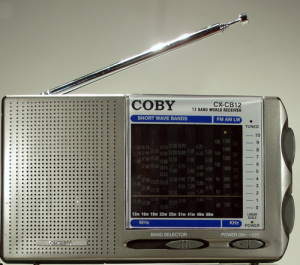
Could this be a tool of international espionage?
Numbers stations have been part of radio lore for decades. If you’ve ever listened to much shortwave radio at some point you would have come across an unidentified station broadcasting only a person reading off numbers, like an endless lotto feed: “21 99 36….” Sometimes this is in English, and often in Spanish or other languages.
The origin and purpose of these stations has been the subject of much debate amongst radioheads. In recent years there has been a growing consensus that at least one purpose was to communicate secret information, probably to foreign agents or spies. However, it the age of email and cell phone you’d think that would make listening to sequences of numbers on a shortwave broadcast obsolete. Apparently not.
A recent Slate article reports that the ten alleged Russian spies arrested two weeks ago–recently swapped in exchange for US agents in Russian custody–were indeed listening to shortwave numbers stations in order to receive information from home. According to the FBI’s complaint against the alleged spies, those arrested
To further the aims of the conspiracy, Moscow Center has arranged for the defendants clandestinely to
communicate with the Russian Federation. In particular, the conspirators have used, among others, the secret communications methods described below – steganography and radiograms.
As evidence that such “radiograms” were received, the complaint goes on to state that
Furthermore, during the 2006 Seattle Search, law-enforcement agents entered the Seattle Apartment and observed there a radio that can be used for receiving short-wave radio transmissions. In addition, agents observed and photographed spiral notebooks, some pages of which contain apparently random columns of numbers. Based on my training, experience, and participation in this investigation, I believe that the radio in the Seattle Apartment was used by the Seattle Conspirators to receive radiograms – and that the spiral notebook contains codes used to decipher radiograms as they came in.
As someone who has tuned in numbers stations since getting my first shortwave radio as a kid at ten years old, I find this all incredibly fascinating. At the same time, using coded one-way radio broadcasts still makes sense if you want to communicate to a person without having to know exactly where he is or accidentally giving away his location. As Slate’s Brett Sokol observes,
even if you locate a spy station’s transmitter, you have no idea who’s tuning in across the hemisphere. Unlike telephone or Internet connections, receiving a radio signal leaves no fingerprint, no traceable phone connection, no IP address, and no other hint as to where the recipient might be.
In fact, according to the article Great Britain’s spy agency also has admitted to using numbers stations, and stations have been tracked down in Israel and the US, although the latter ceased broadcasting in the 1990s.
While I don’t necessarily endorse international espionage, this just provides another reason why the particular qualities of radio makes it so suited for one-way communication, often over long distances. While you can achieve this over the internet or over phones, radio still requires only the most basic equipment to receive messages, whether they’re secret codes or emergency information. No cell tower, ethernet port, or even power outlet required (if you have batteries or a crank radio).


